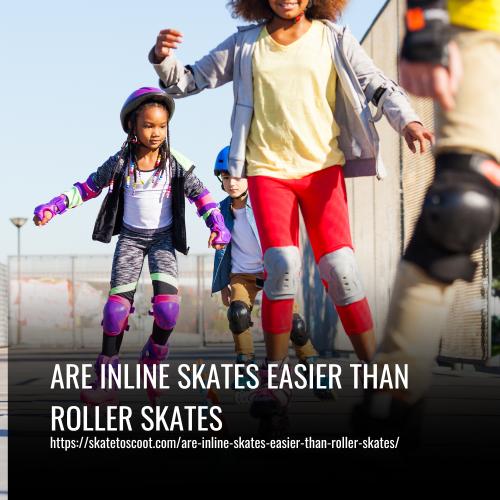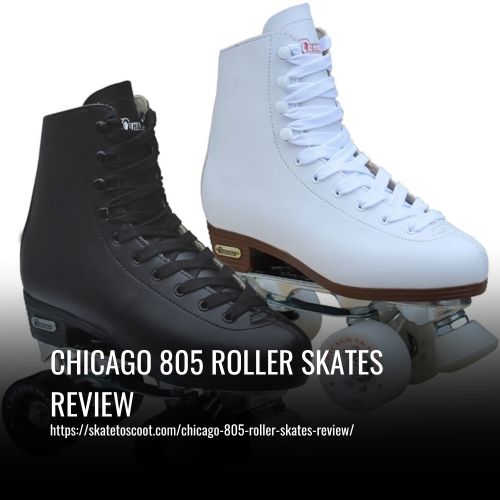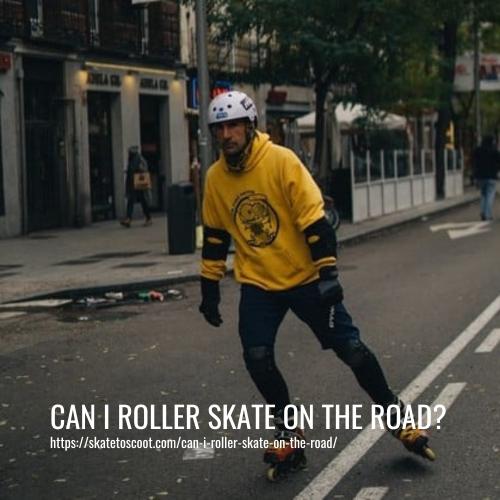As an Amazon Associate we earn from qualifying purchases.
Inline skates, also known as roller blades, are generally considered easier to learn than roller skates. This is because inline skates offer more support for the feet and ankles, making them more stable and easier to balance.
Additionally, inline skates are more agile and allow for better maneuverability, which can make learning and skating easier for some individuals. Furthermore, inline skates typically have larger wheels, which can help with speed and momentum.
Overall, while personal preferences and individual skill levels may vary, many people find inline skates to be easier to use than roller skates.

What Factors Make Inline Skates Easier Than Roller Skates?
If you’re looking for an exciting way to get around, you may have been pondering the differences between rollerblades and quad skates. Don’t worry, though- there are plenty of distinct features that make them two different rides!
1. Wheel Arrangement, Number, and Attachment
Rollerskates and Rollerblades differ in terms of wheel arrangement, number, and attachment.
A rollerskate is designed with 4 wheels placed into a rectangular shape, while a rollerblade is outfitted with more wheels (from 4 to 10), arranged along the boot in a straight line.
Furthermore, roller skates have two skateboard-style trucks which provide support for four wheels – two on each side of the boot.
In comparison, rollerblades don’t feature separate trucks for the wheels; instead, their frames are attached directly to the boot and contain all of the in-line wheels.
These exciting design elements make roller skates and rollerblades unique skating experiences.
2. Boot Type and Flexibility
When it comes to choosing between a rollerskate and a rollerblade, boot type is one of the key things you need to consider. A rollerskate boot looks more like the upper of a regular shoe, which allows for more flexibility and an overall more comfortable fit. The stiffness of this type of boot also helps to promote better performance, meaning that both quad skates and recreational rollerskates are comfy enough for your everyday skating adventures.
On the other hand, rollerblades usually come with boots that offer lots of ankle support. This makes them ideal for going over tougher terrain or performing complex tricks – but don’t worry: if you’re mainly looking for comfort and casual skating, there are plenty of recreational rollerblades with flexible boots that will be just as comfortable as rollerskates. No matter which type of skate you choose, you’ll be able to find one with a boot that offers the level of comfort and flexibility you desire.
3. Skate Speed; What Skate is Faster?
When it comes to skating, speed is king, and the two skate types available – rollerskates (or quads) and rollerblades – differ significantly in this respect. Rollerblades possess larger wheels – ranging from 58mm-65mm diameter – and thus provide a faster ride due to increased surface area and decreased rolling resistance. Additionally, inline skates are more aerodynamic than quads, leading to even greater speed.
Rollerskates have smaller wheels with a range of 68mm-110mm diameter making them slower overall than their rollerblade counterparts but they are still very fast. Due to the small size of their wheels, they also require less energy to start and accelerate which can be beneficial for longer-distance skating or when weight loss is desired.
Ultimately in terms of speed, rollerblades will provide you with the greatest advantage, but both skate types come with their own benefits that should be taken into consideration when determining what type of skate works best for you and your intended skating activities.
4. Where the Skate is Used (the Skate’s Purpose)
The purpose of a rollerskate and a rollerblade vary depending on the space they are used in. Rollerskates, or quad skates, are generally used indoors, like at roller rinks for roller dancing or watching people skate around an arena. Quad skates are perfect for roller hockey and rink hockey. Though quads can be used outdoors as well, this is not where they shine most.
In contrast, most people use inline skates mostly for outdoor skating since this was initially intended to be something guys did when the winter ice skating season ended due to its similarity to ice skating as far as technique and form. Unfortunately, since 2013 there has been less interest in rink hockey so these days few people—mostly teenage girls—rollerblade anymore.
5. Skate Stability and Agility
When it comes to stability and agility, rollerskates and rollerblades each have their own advantages. Right out of the box, quad skates are generally easier to balance on than inline skates–especially for novice skaters. Additionally, they feel more stable when skating slowly on smooth surfaces, giving you a sense of security as you learn the basics. It’s important to note, however, that this stability has its disadvantages; taking sudden falls can be quite problematic when your skate is inherently unstable.
Rollerblades have a benefit when it comes to rolling over obstacles like small rocks; since their frame doesn’t flex much, it’s less likely that you’ll trip up. On the other hand, this decrease in agility takes away the fun of highly maneuverable quad skates that make sharp turns virtually effortless — perfect for those who want to explore roller dance. Ultimately, choosing between rollerskates and rollerblades is a personal choice; both offer unique benefits depending on specific needs and preferences.
6. The Braking System and Ease of Stopping
The braking system and ease of stopping are one areas where rollerskates and rollerblades differ significantly. While both require a bit of a learning curve to become proficient, it’s much easier to stop on quads than inlines.
Rollerskates feature a braking system on the front which looks like a knob. To stop, all you need to do is drag your toe in a certain way and you’re set. On the other hand, an inline skate has its brakes located on the back usually only found on beginner blades. It takes some practice but once you’ve mastered blading you can even remove the brake altogether due to increased control while at high speeds.
Rollerblading vs. Rollerskating
Rollerblading and rollerskating are two popular recreational activities. While their names are similar, there are some key differences between these two activities.
When rollerskating, the four-wheeled wheels are placed side-by-side with the skateboard-style trucks. However, when rollerblading, a frame is attached to 4, 6, 8, or even up to 10 wheels.
The obvious difference is that typically rollerskates are designed for indoor use while inline skates work better outdoors due to their larger wheel size which will help you maneuver better on different terrains.
It’s important to note that rollerskating may feel easier for beginners who just want to get started due to the extra stability provided by the four small wheels side-by-side – inline skating has more of a challenge and the learning curve increases with your skill level.
That being said, both rollerblades and rollerskates can be picked up fairly quickly by new enthusiasts!
FAQs
The main distinction between inline and roller skates is the configuration of their wheels: inline skates have 3-5 wheels in a line, while roller skates typically have 4 wheels arranged in two rows of two.
For a novice, roller skates offer more stability, while inline skates are better for maneuvering and agility.
The braking technique varies because of the varied construction and brake placement in roller skates.
When braking, beginners should start by leaning forward with bent knees to maintain balance. Then extend one leg so the rear brake presses against the ground — it’s an easy skill to learn.
If you own inline skates without brakes, you will need to learn specific braking techniques. Without the brake, you must use your feet to stop. You do this by dragging one foot back at right angles to the other until a T shape is formed.
After that, use the inner edges of the wheels to drag them vertically along the ground for braking. Although it may be hard to learn, this technique is safer than stopping with just a brake and will help you stop safely while inline skating.
Stopping while roller skating can seem intimidating, but it is actually quite easy once you get the hang of it. Most roller skates are designed with a braking system that is located at the front of the skate, and all you have to do is drag your legs back while putting pressure on the brakes in order to slow or stop your motion.
It may take a bit of practice to get it right, as some techniques require more skill than others. But with time and patience, anyone can develop their own unique style of slowing down and stopping that works best for them.
When it comes to safety, deciding between inline skates and roller skates can be a difficult choice. Many people worry about which one is less dangerous – and the answer is not so clear-cut.
A 2001 US Consumer Product Safety Commission survey suggests that, compared to other more popular sports, roller skating is actually safer than some may realize. Injuries per 1,000 participants were found to be lower when roller skating was involved, indicating that it may be a safer option than inline skates.
Inline skates are suitable for both indoor and outdoor use. Additionally, they perform better and can travel longer on outdoor terrain due to their higher speed and ability to traverse rough surfaces.
In an ideal situation, I would suggest that 4 years old is the perfect age to begin skating. At this stage, they have already begun attending school and understand the concept of following instructions from the teacher.
The distinction between roller skates and rollerblades lies in the arrangement of the wheels. Roller skates contain two distinct trucks or hangars that rest horizontally – one near the toes and one behind the heel – while inline skates possess a single central frame with a connected line of wheels.
You can start roller skating at any age. However, the best age would be right when a child can stand on their own and walk without support. For adults, there’s no age limit. You can always start whenever you’re ready.
Beginners will find recreational skates, fitness skates, hockey skates, and aggressive skates better because they have a relatively small wheel that gives more stability. Also, skates with four or five wheels offer more stability and thus would pass for better skates for beginners.
Getting good at roller skating takes effort. However, when factors are constant, one should take between four to eight weeks to go from a beginner to an intermediate skater. To get good, it can take up to 12 months, depending on how frequently one practices.
Conclusion:
Inline skates may seem like a very convenient option compared to roller skates, but in the end, it all depends on personal preference. Despite their similarities, inline and roller skates require different skills to skate well. If you are looking for an easier skating experience, then inline skates may be the right choice for you. However, if you prefer the look and feel of traditional roller skates or just enjoy the extra challenge of mastering them, then they may be a better option.
Amazon and the Amazon logo are trademarks of Amazon.com, Inc, or its affiliates.



